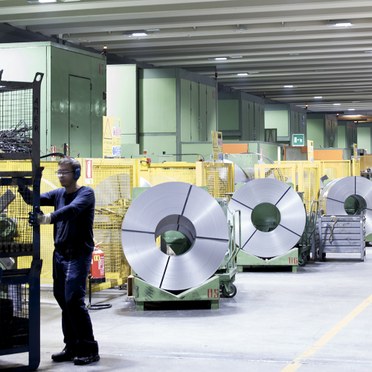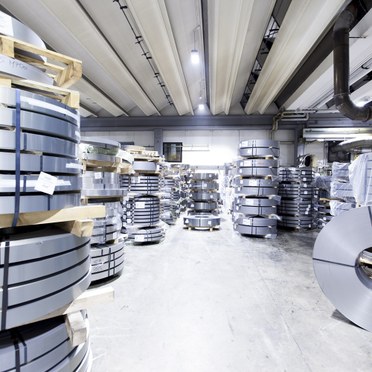CR Mechanical Factory, Italy
- Lamp efficacy
Lamp efficacy
High efficacy LED light sources convert energy more efficiently into light, reducing energy consumption.
- Ballast classification
Ballast classification
Controlling the electricity supply to the lamp (Energy Efficiency Index).
- Luminaire distribution
Luminaire distribution
Controlling light emission using optics which bend and shape the light to the correct location.
- System efficacy
System efficacy
Combining optical and thermal control within the luminaire (luminaire lm/W).
- Presence/absence detection
Presence/absence detection
Presence: Lights automatically turn on/off with movement. Absence: Lights automatically turn off and must be manually switched on.
- Daylight detection
Daylight detection
Artificial lighting which responds to the natural light conditions.
- Constant illuminance
Constant illuminance
A function designed to produce correct light levels for the duration of the maintenance period.
- Task-scene setting
Task-scene setting
Allowing the user to set scenes and adapt the lighting to different tasks.
- Timed off
Timed off
Automatic cut-off can be installed to turn all lights off during unoccupied hours.
- Task lighting
Task lighting
Careful design of the lighting installation concentrates light onto the task area. This ensures a well-lit environment and highly efficient use of light.
- Zoning of lighting
Zoning of lighting
In combination with switching arrangements, the lighting can be zoned according to use to minimise energy consumption in areas where it is not needed.
- Maintenance schedule
Maintenance schedule
Maintenance must be performed in response to product age, performance and environment.
- Waste light
Waste light
Eliminating waste light which does not hit the intended target.
- Reflectance
Reflectance
Taking advantage of light which is reflected from the surface within the space.
- Visible smart metering
Visible smart metering
Results of actions can be quickly seen as increased or decreased energy use to encourage responsible energy consumption.
Founded in 1972, CR is a machine workshop in Vicenza which required a lighting refurbishment to reduce energy consumption and improve the quality of light in accordance with the UNI 12464-1 standard for indoor workplace lighting. The existing lighting installation comprised 50 traditional industrial suspended luminaires with 400W metal halide lamps. Lighting levels were on average between 150 and 250 lux. Working with CR the lighting designer Ind. Giorgio Reffo initially evaluated the benefits of an installation comprising of either a new metal halide or fluorescent solution. The results however fell short of objectives.
Lighting solution
Marco Bacco, Thorn Energy Partner, therefore proposed HiPak Pro LED (150W,14 000lm). HiPak Pro LED is a robust, low maintenance and energy saving LED high bay luminaire. It features dedicated individual LED optics for precise light control and an integrated PIR sensor, as well as being DALI dimmable for maximum energy savings.
Marco explains: “The UNI 12464-1 standard is very complex and demanding. The values for illuminance, UGR, Uo and Ra have different value combinations in relation to each visual task that is performed in a workshop. To provide the right lighting solution it is therefore necessary to know the tasks performed in each area in question and analyse the features of the products that is intended to be used. The CR machine workshop completes a diverse range of projects for approximately 20 sectors, ranging from agriculture to woodworking. It has a total of 138 different visual tasks and 39 different classifications of lighting performance (from 20 to 2000 lux) to take into consideration.”
Results and benefits
HiPak Pro LED effortlessly covered all of the workshop’s functions. In the corridors for example, the light output has been set to 200 lux while in critical workspaces it increases to 400 lux. The new lighting is fully compliant with UNI 12464-1 and creates a good working environment for staff to work efficiently and productively.
As well as increasing light output, HiPak Pro LED has reduced energy consumption by 62,5%, from 80 kWh to 30 kWh. This will deliver a return on investment in 3.3 years. Further savings will also be achieved as a result of the reduced maintenance requirements associated with LED lighting.
- CR Mechanical Factory, Italy
(PDF/
894 KB)
Download as a PDF.


